Here’s an extremely interesting video of me working through 5 labs of physical computing.
[vimeo https://vimeo.com/74586656 w=640]
Here’s an extremely interesting video of me working through 5 labs of physical computing.
[vimeo https://vimeo.com/74586656 w=640]
Here’s a sleepy and completely unedited (but not drunk) recounting of a famous moment in Italian history from a tired PhD student. For a potential sound project…
[soundcloud url=”http://api.soundcloud.com/tracks/109829018″ params=”” width=” 100%” height=”166″ iframe=”true” /]
In “On The Rights of Molotov Man”, Susan Meiselas describes how her journalistic photograph lost its historical context as it was appropriated and used by different groups for a variety of purposes.

The subject of the photo (the subject of any photo) is in fact a historical actor, a real person in space and time. In this case, his name is Pablo Arauz.

Over the years, the historical reality of the photograph is forgotten. Icon replaces photograph: we no longer know who this person is, where they are, what their political reality is, why they might be throwing a molotov cocktail.
This image, and other images that have experienced a similar evolution, are empty, or sliding, signifiers. They are symbols disconnected from meaning.
Through the long process of re-use, the image loses all connection to the meaning that it once referred to. It exists on it’s own, in a void. The image/sign is no longer connected to meaning/history/context.
In this way, a hammer and sickle can transform into a bourgeois coffee cup.
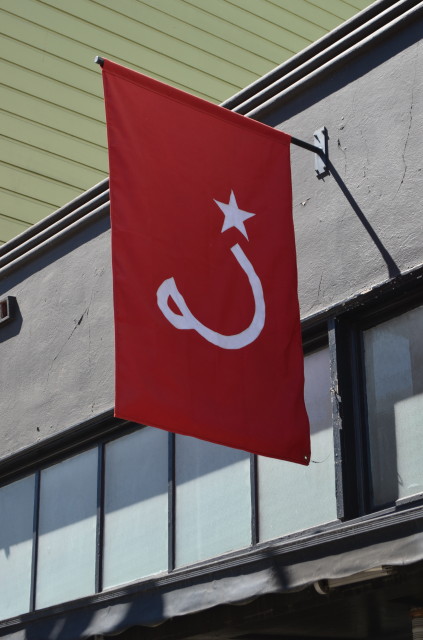
The work by Miesas is eventually appropriated by Joy Garnett, who reproduces the image in oil paint. But long before Molotov Man is appropriated by Joy, it has already become what we might call a “meme”: A vehicle or tool for expression, rather than the worked production of expression.
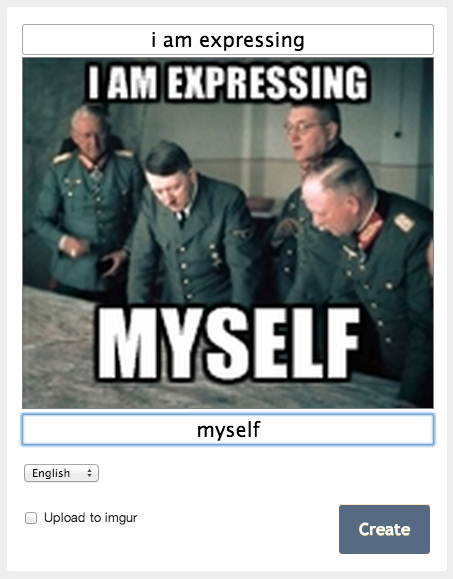
In the past this loss of signification might take decades or centuries.

It can now, through the magic and arbitrary nature of the internet, happen almost instantaneously.
Any image, at any moment can be removed from its historical reality, emptied of original meaning and transformed into pure symbol. It can even happen to you!
Note: if it does happen to you, you can hire a meme manager.
The question I am interested in, is what do we find when we successfully trace back from the anti-historical meme to its real-life original subject?
Here is Scumbag Steve.

Here is IRL Blake Boston pretending to be internet Scumbag Steve.
Blake is performing an image of himself in exchange for cash. It is as if Meiselas had gone back to Nicaragua only to find Pablo Arauz still throwing his molotov cocktail.
The process of de-signification is analogous to the process by which a natural resource is transformed into a commodity. Meaning is emptied away and the historical reality forgotten: “From the taste of wheat it is not possible to tell who produced it, a Russian serf, a French peasant or an English capitalist”. The wheat has a history but no one knows what it is.
Scumbag Steve has achieved commodity status; he has successfully decontextualized himself.
First class in Physical Computing we were tasked with coming up with a prototype for a fantastical device. Saki, Michelle and I decided to work on the concept of an “Infinite Container”.
Here’s our final invention, in all its glory.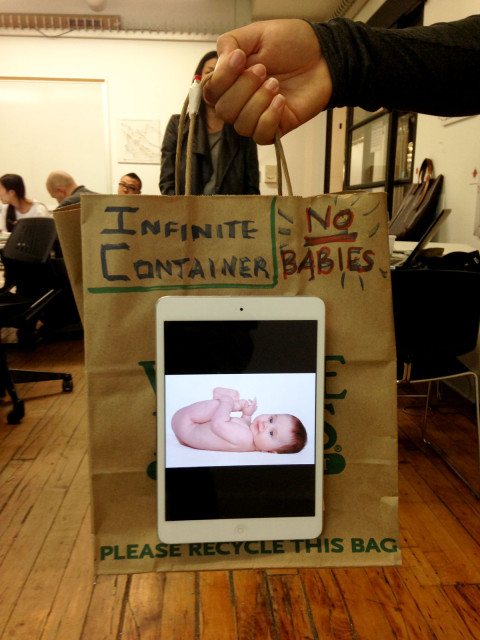
As you can see we opted for a skeuomorphic Whole Foods paper grocery bag. The iPad mini duct-taped to the front of the device gives users access to the contents of the Infinite Container. Someone has decided to store a baby in this container, despite the unambiguous warning.
A button, ergonomically affixed to the bag handle, allows for convenient ingress and egress of objects via the object-capturing receptacle located discretely on the side of the device.
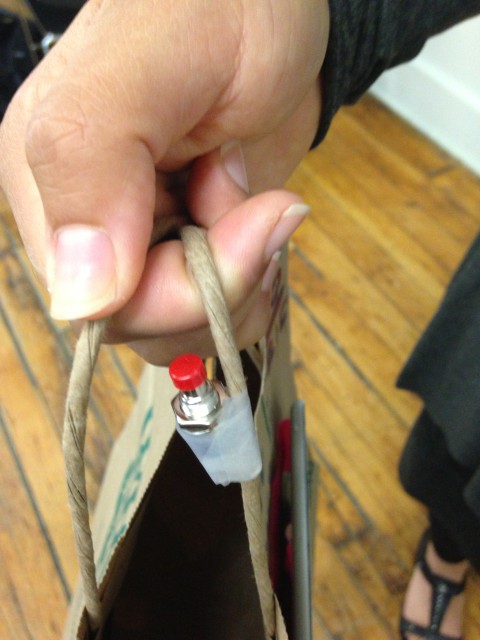

For our first assignment in Intro to Computational Media, Daniel asked us to play around with shape primitives in Processing and “make something static”.
I started experimenting with shapes and colors and came up with the sun-like sketch below. Note – this isn’t quite static – you can click on the sketch to generate a new, semi-randomized sun. Clicking more to the right will generate more sun rays, and clicking more towards the bottom will alter the background color slightly.
|
1 2 3 4 5 6 7 8 9 10 11 12 13 14 15 16 17 18 19 20 21 22 23 24 25 26 27 28 29 30 31 32 33 34 35 36 37 |
int rays = 24; void setup() { size(640, 460); colorMode(HSB, 100, 100, 100, 100); noStroke(); drawSun(); } void draw() {} void drawSun() { background(map(mouseY, 0, height, 40, 60), 10, 100); pushMatrix(); translate(width / 2, height / 2); rays = (int) map(mouseX, 0, width, 6, 20) * 2; for (int i = 0; i < rays; i++) { fill(random(20), 100, 100, 90); triangle( random(10, 30), random(20, 30), random(20, 30), random(5, 8), width / 2, height / 2 ); rotate(TWO_PI/ rays); } popMatrix(); fill(0, 0, 100); ellipse(width / 2, height / 2, 120, 120); } void mouseReleased() { drawSun(); } |
Afterwards I made this goofy hand/recursion thing that really had nothing to do with the assignment (inspired by this work). Move the mouse around to play with scale etc.
Here’s a screenshot of another version:
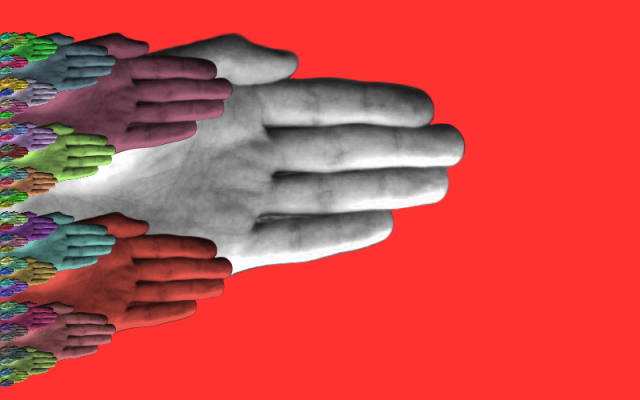
|
1 2 3 4 5 6 7 8 9 10 11 12 13 14 15 16 17 18 19 20 21 22 23 24 25 26 27 28 |
PImage img; int levels = 4; float scale_by = 2; float displace_l = 5; float displace_r = 2; void setup() { size(640, 600); img = loadImage("/wp-content/uploads/2013/09/hand.png"); } void draw() { background(255, 50, 50); scale_by = map(mouseY, 0, height, .5, 6); drawHand(mouseX - img.width/2, height - img.height, 1, levels); } void drawHand(int x, int y, float scale, int level) { image(img, x, y, img.width*scale, img.height*scale); if(level > 1) { level = level - 1; drawHand(x - int(img.width * scale / displace_l), height - int(img.height * (scale / scale_by)), scale / scale_by, level); drawHand(x + int(img.width * scale / displace_r), height - int(img.height * (scale / scale_by)), scale / scale_by, level); } } |